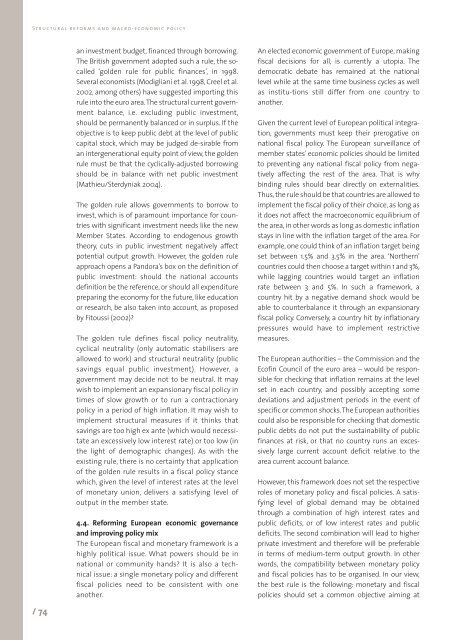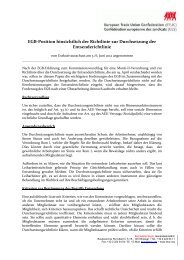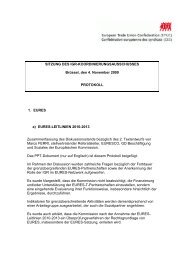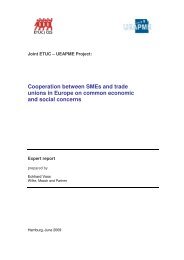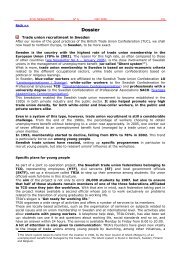Structural reforms and macro-economic policy - ETUC
Structural reforms and macro-economic policy - ETUC
Structural reforms and macro-economic policy - ETUC
You also want an ePaper? Increase the reach of your titles
YUMPU automatically turns print PDFs into web optimized ePapers that Google loves.
<strong>Structural</strong> <strong>reforms</strong> <strong>and</strong> <strong>macro</strong>-<strong>economic</strong> <strong>policy</strong><br />
/ 74<br />
an investment budget, financed through borrowing.<br />
The British government adopted such a rule, the socalled<br />
‘golden rule for public finances’, in 1998.<br />
Several economists (Modigliani et al. 1998, Creel et al.<br />
2002, among others) have suggested importing this<br />
rule into the euro area.The structural current government<br />
balance, i.e. excluding public investment,<br />
should be permanently balanced or in surplus. If the<br />
objective is to keep public debt at the level of public<br />
capital stock, which may be judged de-sirable from<br />
an intergenerational equity point of view, the golden<br />
rule must be that the cyclically-adjusted borrowing<br />
should be in balance with net public investment<br />
(Mathieu/Sterdyniak 2004).<br />
The golden rule allows governments to borrow to<br />
invest, which is of paramount importance for countries<br />
with significant investment needs like the new<br />
Member States. According to endogenous growth<br />
theory, cuts in public investment negatively affect<br />
potential output growth. However, the golden rule<br />
approach opens a P<strong>and</strong>ora’s box on the definition of<br />
public investment: should the national accounts<br />
definition be the reference, or should all expenditure<br />
preparing the economy for the future, like education<br />
or research, be also taken into account, as proposed<br />
by Fitoussi (2002)?<br />
The golden rule defines fiscal <strong>policy</strong> neutrality,<br />
cyclical neutrality (only automatic stabilisers are<br />
allowed to work) <strong>and</strong> structural neutrality (public<br />
savings equal public investment). However, a<br />
government may decide not to be neutral. It may<br />
wish to implement an expansionary fiscal <strong>policy</strong> in<br />
times of slow growth or to run a contractionary<br />
<strong>policy</strong> in a period of high inflation. It may wish to<br />
implement structural measures if it thinks that<br />
savings are too high ex ante (which would necessitate<br />
an excessively low interest rate) or too low (in<br />
the light of demographic changes). As with the<br />
existing rule, there is no certainty that application<br />
of the golden rule results in a fiscal <strong>policy</strong> stance<br />
which, given the level of interest rates at the level<br />
of monetary union, delivers a satisfying level of<br />
output in the member state.<br />
4.4. Reforming European <strong>economic</strong> governance<br />
<strong>and</strong> improving <strong>policy</strong> mix<br />
The European fiscal <strong>and</strong> monetary framework is a<br />
highly political issue. What powers should be in<br />
national or community h<strong>and</strong>s? It is also a technical<br />
issue: a single monetary <strong>policy</strong> <strong>and</strong> different<br />
fiscal policies need to be consistent with one<br />
another.<br />
An elected <strong>economic</strong> government of Europe, making<br />
fiscal decisions for all, is currently a utopia. The<br />
democratic debate has remained at the national<br />
level while at the same time business cycles as well<br />
as institu-tions still differ from one country to<br />
another.<br />
Given the current level of European political integration,<br />
governments must keep their prerogative on<br />
national fiscal <strong>policy</strong>. The European surveillance of<br />
member states’ <strong>economic</strong> policies should be limited<br />
to preventing any national fiscal <strong>policy</strong> from negatively<br />
affecting the rest of the area. That is why<br />
binding rules should bear directly on externalities.<br />
Thus, the rule should be that countries are allowed to<br />
implement the fiscal <strong>policy</strong> of their choice, as long as<br />
it does not affect the <strong>macro</strong><strong>economic</strong> equilibrium of<br />
the area, in other words as long as domestic inflation<br />
stays in line with the inflation target of the area. For<br />
example, one could think of an inflation target being<br />
set between 1.5% <strong>and</strong> 3.5% in the area. ‘Northern’<br />
countries could then choose a target within 1 <strong>and</strong> 3%,<br />
while lagging countries would target an inflation<br />
rate between 3 <strong>and</strong> 5%. In such a framework, a<br />
country hit by a negative dem<strong>and</strong> shock would be<br />
able to counterbalance it through an expansionary<br />
fiscal <strong>policy</strong>. Conversely, a country hit by inflationary<br />
pressures would have to implement restrictive<br />
measures.<br />
The European authorities – the Commission <strong>and</strong> the<br />
Ecofin Council of the euro area – would be responsible<br />
for checking that inflation remains at the level<br />
set in each country, <strong>and</strong> possibly accepting some<br />
deviations <strong>and</strong> adjustment periods in the event of<br />
specific or common shocks.The European authorities<br />
could also be responsible for checking that domestic<br />
public debts do not put the sustainability of public<br />
finances at risk, or that no country runs an excessively<br />
large current account deficit relative to the<br />
area current account balance.<br />
However, this framework does not set the respective<br />
roles of monetary <strong>policy</strong> <strong>and</strong> fiscal policies. A satisfying<br />
level of global dem<strong>and</strong> may be obtained<br />
through a combination of high interest rates <strong>and</strong><br />
public deficits, or of low interest rates <strong>and</strong> public<br />
deficits. The second combination will lead to higher<br />
private investment <strong>and</strong> therefore will be preferable<br />
in terms of medium-term output growth. In other<br />
words, the compatibility between monetary <strong>policy</strong><br />
<strong>and</strong> fiscal policies has to be organised. In our view,<br />
the best rule is the following: monetary <strong>and</strong> fiscal<br />
policies should set a common objective aiming at


